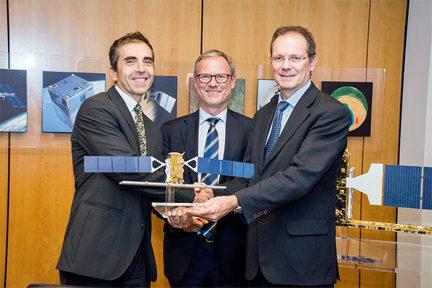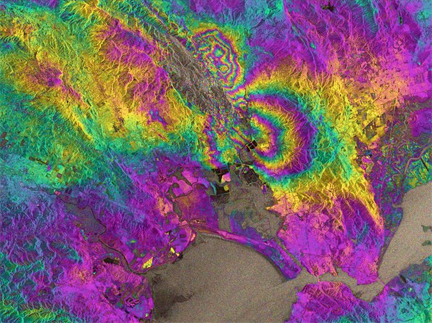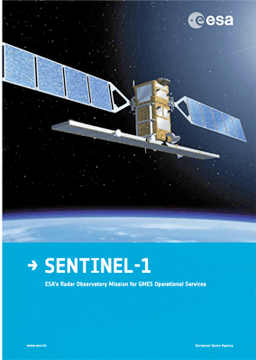
[SatNews] With the commissioning of Sentinel-1A completed and the satellite’s transfer to the team in charge of its exploitation, its data are available immediately to all users.

Marking the beginning of its operational life, Sentinel-1A was formally transferred from Project Manager Ramón Torres (left) to the Mission Manager Pierre Potin (right) on 25 September 2014 in the presence of ESA’s Director of Earth Observation Programmes, Volker Liebig (center).
Photo is courtesy of ESA.
This marks the beginning of the satellite’s operational life, delivering radar coverage for an array of applications in the areas of oceans, ice, changing land and emergency response. Project Manager Ramón Torres, who led the development team, formally handed over the satellite to the Mission Manager, Pierre Potin.
“The time has arrived for the satellite to exploit its extraordinary capabilities and start helping users,” said Ramón. “A leap forward from ESA’s earlier Envisat, the unprecedented quality of Sentinel-1A will ensure that all users’ needs are fully met. Of course, saying farewell is always difficult, but I am confident that it is in capable and safe hands for the next stage of its journey.”
Launched on April 3rd, Sentinel-1A completed commissioning on September 23rd—an important process that ensures the satellite, instruments, data acquisition and data processing procedures are working well. Not only did Sentinel-1A pass these tests and reach its target orbit on August 7th, eight anticollision manoeuvres to avoid space debris were performed during this phase. The satellite will now begin delivering radar scans for an array of operational services and scientific research.

The biggest earthquake in 25 years struck California’s Napa Valley in the early hours of 24 August 2014. By processing two Sentinel-1A images, which were acquired on 7 August and 31 August 2014 over this wine-producing region, an interferogram was generated. The two round shapes around Napa valley, which are visible in the central part of the image show how the ground moved during the quake. Deformation on the ground causes phase changes in radar signals that appear as the rainbow-colored patterns. Each color cycle corresponds to a deformation of 28 mm deformation. The maximum deformation is more than 10 cm, and an area of about 30x30 km was affected significantly. Interferograms like these are being used by scientists on the ground to help them map the surface rupture and model the earthquake. This interferogram very clearly shows the fault that caused the earthquake, which had not been identified as being particularly hazardous prior to the event. Despite this interferogram being computed with images acquired in the satellite’s ‘stripmap mode’, which is not going to be the default mode when operational, this result demonstrates the capability of Sentinel-1A and marks the beginning of a new era for our ability to map earthquakes from space.
Image courtesy of ESA.
“My main objective is to ensure that Sentinel-1 fulfills the high expectations from the various operational services and scientific users,” said Pierre. “Looking at the satellite and ground segment performance—as demonstrated during the commissioning—as well as the preliminary results achieved so far, I’m confident that the mission will be a great success.”
The satellite will continue to be monitored, operated and controlled from ESA’s Space Operations Centre in Darmstadt, Germany. The Sentinels are a new fleet of ESA satellite poised to deliver the wealth of data and imagery that are central to Europe’s Copernicus program. By offering a set of key information services for a broad range of applications, this global monitoring programme is a step change in the way we manage our environment, understand and tackle the effects of climate change, and safeguard everyday lives.
Sentinel-1 – a two-satellite constellation – is the first in the series and carries an advanced radar to provide an all-weather, day-and-night supply of imagery of Earth’s surface. Even during commissioning, Sentinel-1A demonstrated its potential in the various applications domains. Just days after launch, its results were included in maps of the floods that hit Namibia, as well as those in the Balkans the following month. This information was then used by authorities involved in flood response.

Radar images were also used to map the rupture caused by the August 24th earthquake that shook northern California, the biggest the area has seen in 25 years. The towing of the Costa Concordia cruise ship off the west coast of Italy was captured by the radar, demonstrating Sentinel-1’s ability to survey the marine environment.
This and many other services will now start benefiting from Sentinel-1A’s operational status. These include services related to monitoring Arctic sea-ice extent, routine sea-ice mapping, surveillance of the marine environment, monitoring land-surface for motion risks, mapping for forest, water and soil management and mapping to support humanitarian aid and crisis situations.
The mission’s contributions will further improve once the satellite’s identical twin, Sentinel-1B, is launched in 2016. The ESA Sentinel-1 infosite may be accessed http://www.esa.int/Our_Activities/Observing_the_Earth/Copernicus/Sentinel-1

